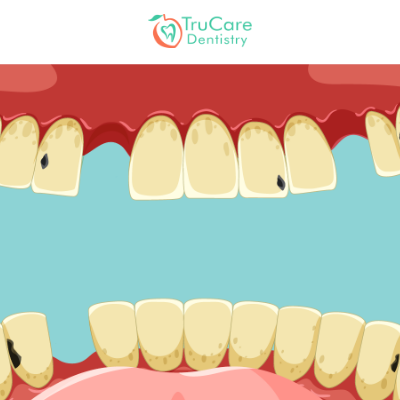
Anodontia is a hereditary condition that causes the missing of all teeth. It is different from the absence of all teeth due to an injury, tooth decay, cavities, or periodontal diseases. It is an autosomal recessive disorder, which means that a child inherits two mutated genes from each of its parents.
At TruCare Dentistry in Roswell, we know the complications anodontia can cause if it’s not diagnosed and fixed on time. In this blog post, we have discussed everything about the condition including its signs and symptoms, similar conditions, diagnosis, and available treatment options. Read on to know more about the congenital condition.
Signs and symptoms of anodontia
The primary symptom of the condition is missing teeth. A baby has reached one year or more and the baby teeth are still missing. A preteen child is 12 years or more and the permanent teeth are still absent.
Some additional signs and symptoms also include:
- The absence of fingernails
- Cleft palate or cleft lip
- Lack of sweating
- Rapid baldness or complete hair loss
Conditions similar to anodontia
Apart from complete anodontia, there are two types of conditions where only a part of teeth are missing.
Hypodontia: It’s a condition where up to six teeth are missing.
Oligodontia: It’s a condition where more than six teeth are missing.
Diagnosis of anodontia
Unlike several other congenital conditions, anodontia is usually diagnosed after a certain age—typically a year or more. That’s because when a baby is born without teeth, it doesn’t immediately set the alarm bells ringing. A majority of babies are toothless at birth, while neonatal teeth and natal teeth are not very common.
Also, the development of baby teeth or permanent teeth can differ among children. The age at which the maiden baby tooth appears can vary from six months in some babies to 15 months in some babies. Likewise, some children don’t get permanent teeth until they are 12 or 13 years old.
But if a baby is still toothless for 15 to 16 months after its birth, then it can be a cause of concern. In case of suspected anodontia, dental X-rays or a physical examination can prove to be useful. If the X-ray reports show that the growth of teeth hasn’t started in the gums, then it’s most likely anodontia.
Treatment options for anodontia, hypodontia, and oligodontia
As anodontia is a genetic condition, no treatment can stimulate the growth of natural teeth. However, there are three main types of treatment options that can provide artificial teeth to people afflicted with the condition and enable them to live a normal life. They are listed below:
Dentures: A complete set of dentures is extremely useful in the case of complete anodontia. Partial dentures and overdentures are the most effective treatment for hypodontia or oligodontia.
Dental implants: Although an expensive treatment option when compared to dentures, these are a permanent solution to both complete and partial anodontia. Providing the look and feel of natural teeth, dental implants remain firmly rooted in the jaw and can last for a lifetime.
Dental bridges: These are effective in the case of partial anodontia i.e. hypodontia or oligodontia, where some teeth are missing.
A particular type of condition will benefit from a specific type of treatment. It’s best to consult with a trustworthy and experienced dentist to know which treatment option is best for a particular case of anodontia.
By and large,
Anodontia is not a dental condition but a genetic disorder that results in missing teeth. Even though it isn’t possible to stimulate the growth of a natural set of teeth, some treatments can give artificial teeth to people afflicted with the condition. A lack of timely treatment can cause a lot of health problems including difficulty in biting and chewing, malnutrition due to insufficient intake of food, various oral problems, low self-esteem, abnormal speech patterns, weakened jaw, and deterioration of jaw bone.
At TruCare Dentistry, we have the treatment options to eliminate the complications caused by anodontia, hypodontia, and oligodontia. Before considering any treatment, it’s prudent to see an experienced, expert, and reliable dentist to know the best option for a specific condition. If you have any queries or concerns regarding the condition, feel free to contact us.
FAQs
1. How common is anodontia?
Anodontia is an extremely rare condition that is found in less than two to eight percent of the total population concerning permanent teeth and 0.1 to 0.7 percent concerning primary teeth.
2. What is false anodontia?
False anodontia is the absence of teeth due to injury, accident, delayed eruption, extraction, or exfoliation.
3. Is anodontia hereditary?
Yes, anodontia is hereditary. Even though some parents don’t show any signs or symptoms of anodontia, they can simply be the carriers of mutated genes responsible for the condition.
4. Which gender is more susceptible to anodontia?
A review by the Dental Research Journal on a wide range of seminal studies found that women are more susceptible to anodontia than men.
5. Can anodontia cause serious problems?
Although Anodontia may not cause life-threatening problems, it can cause many physical and psychological complications ranging from an altered bite, dietary disorders, abnormal speech patterns, difficulty in maintaining oral hygiene, low self-esteem, weakened jaw, and deterioration of jaw bone.
